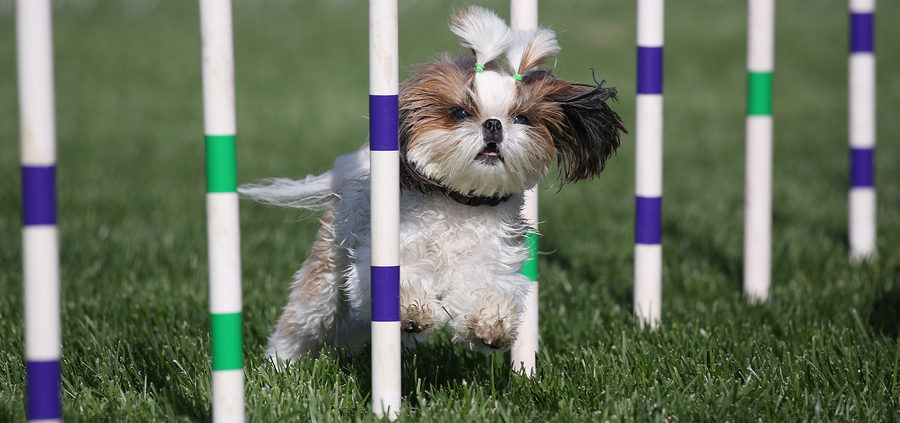Is walking your dog getting to be a drag? Do you and your dog want to be more active outdoors? Have you ever thought it would be fun to try a dog sport but don’t know which one, how to get started, or where to practice? We have the answers that will get you and your dog up and at ‘em.
Which Sport?
Among the most popular and accessible dog sports are agility, flyball, flying disc games, nosework, swimming or dock diving, and tracking. Here’s the scoop on each one:
–In agility, dogs race against the clock, navigating a series of jumps, tunnels, A-frames, hoops, teeter-totters, and weave poles.
–Flyball is a team relay race in which the dog must jump four hurdles, press a lever to release a tennis ball from a box, and race back over the hurdles so the next dog can go.
–You can throw a flying disc, or Frisbee, for your dog to retrieve anywhere, but you can also enter canine disc competitions together in events such as distance catching or freestyle catching.
–Dogs who love to sniff excel in nose work and tracking. In nose work, or scent work, the dog searches for a specific odor (birch, anise, or clove) hidden in a container, room, vehicle, or outdoor area, alerting the handler when it’s found by sitting, looking at the handler, or offering some other signal. In tracking, the dog follows a human scent trail to find a scent article.
–Water-loving dogs enjoy swimming for fun—whether in a pool, lake, or other body of water—or the competitive sport of dock diving, which measures how far they can jump before splashdown.
Your dog’s build and activity level all determine what he’ll be best at. Basset Hounds can do agility, for instance—one named Diesel is a YouTube star—but they’re never going to be the fastest dog on the block. The breeds that excel at agility are typically small to medium-size dogs such as Papillons, Jack Russell Terriers, Shetland Sheepdogs, Border Collies and Australian Shepherds. But if you’re in it for fun, not ribbons, any dog can play.
Dogs who love running, jumping, and retrieving are best for flying disc games. They include Golden and Labrador Retrievers, Whippets, Border Collies, Rat Terriers, and Australian Cattle Dogs. Dogs with long backs, such as Dachshunds or Corgis, should sit this game out.
Any dog can do nose work, no matter what their size or age. It’s perfect for dogs who are uncomfortable around other dogs because only one dog searches at a time and dogs are not allowed to come near each other on the way to and from searches. It’s also open to dogs with vision or hearing loss or who have lost a limb. The same is true for tracking (except that dogs with vision loss may not enter tracking tests).
Swimming or dock diving are not only fun, they’re also great exercise. Just be prepared to get wet yourself when your dog shakes off afterward.
Getting Started
If you’re lucky, you live in an area with lots of dog-training classes and activities. Beyond basic puppy and manners classes, many dog-training facilities offer courses in one or more of these activities. You can also contact national organizations for each sport to see if they can refer you to a trainer in your area. Here’s where to look:
–Agility. Many organizations offer agility trials. Here’s a comprehensive list.
–Flyball. At the North American Flyball Association website you can find rules, teams in your area, and information on titling.
–Canine disc. Disc dog clubs are listed on the Skyhoundz website.
–Dock diving. Organizations include Dock Dogs, North America Diving Dogs, Splash Dogs, and Ultimate Air Dogs.
–Nose work and scent work. Nose work is governed by the National Association for Canine Scent Work. The American Kennel Club also offers scent work competitions.
–Tracking. The American Kennel Club and Australian Shepherd Club of America offer tracking tests and titles for dogs who pass them.
Where to Play
For fun, you can play any of these sports in your backyard or a nearby dog-friendly park if you have the right equipment. Training facilities may also have areas where you can practice.
But what if you don’t have access to a pool, a big yard, or a full-service training facility? You may be able to find a practice or play spot through Sniffspot.com. Owners with yards, pools, and acreages list their places for hourly rental, and you won’t encounter other dogs there unless you’ve organized your own play group with known dogs. Some have pools, ponds, agility or other equipment on site.
As far as competitions, they take place around the country, and there is usually something going on in every sport on any given weekend. If you’re not ready to compete, consider volunteering. It’s a great way to learn and to make new friends.
Trying out a sport or activity is good for canine body and soul, as well as for the relationship between you and your dog. You’ll find that as you grow as a team, you’ll both be happier and more connected. Have fun!
This article was reviewed/edited by board-certified veterinary behaviorist Dr. Kenneth Martin and/or veterinary technician specialist in behavior Debbie Martin, LVT.








